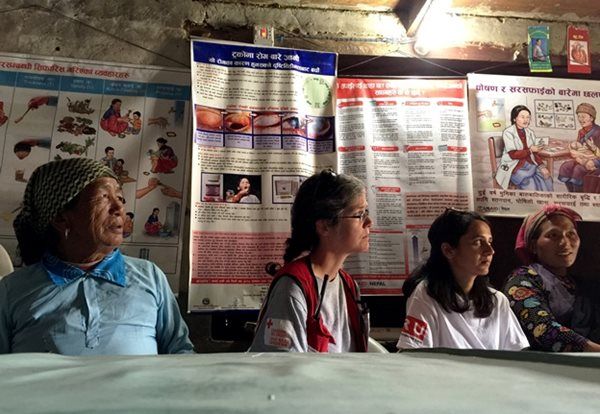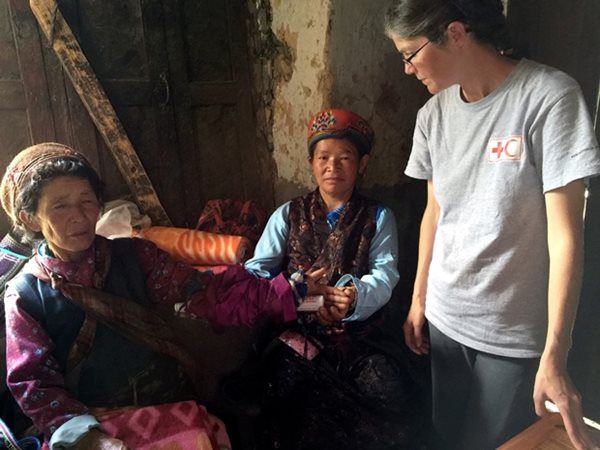Red Crosser Nicole Robicheau is currently in Nepal, where she is sharing updates on how the Canadian Red Cross is providing aid after the recent earthquakes.

Red Cross community health nurse Elizabeth Hinton and Nepal Red Cross volunteer Nonie Bhattara listen to community health volunteers in Goljung, Rasua district. /Photo courtesy: N. Robicheau

Red Cross community health nurse Elizabeth Hinton demonstrates how to make a splint for a broken arm. /Photo courtesy: N. Robicheau
Eight colourfully dressed Tamang women sit in the community health post in Goljung in Rasua district, high in the Himalayas of Nepal. They’re the local community health volunteers and they usually take care of 10 to 15 patients a day in the remote community of 1,000. Today they’ve gathered around to meet the Canadian Red Cross health team.
“Do you have access to safe drinking water?” asks Red Cross community health worker Elizabeth Hinton, through a local translator.
“There is no water treatment here, some boil their water, some have filters but most drink directly from water sources,” explains Red Cross volunteer Noney Bhattara. “People are engaged in agriculture here and they don't carry water with them when they go to the fields, they just drink from the natural sources and pipelines.”
As a community health nurse, Hinton works with local Red Cross branches, community volunteers, and village health workers to raise awareness and build capacity in health issues such as first aid and basic hygiene.
“When people are displaced and their environment has been disrupted, normal hygiene practices are no longer possible and our role is to help them adapt to their new environment,” says Hinton. “This is important especially now during monsoon season to prevent epidemics from happening.”
Hinton asks the health volunteers if they know what to do if someone breaks their arm. They say they don’t. Hinton stands up, grabs two calendars and rolls them up, places them on each side of the arm and holds them in place with a jacket.
“You see? Above the elbow so the elbow is being blocked and the wrist, like this,” says Hinton.
For many remote communities in this area of Nepal, these posts are the only health facilities people have access to. The nearest district hospital is a couple of hours away by car, depending on the condition of the roads. During monsoon season, landslides often cut off communities like this, sometimes for weeks at a time.
“This is why building the capacity of communities to take care of themselves is particularly important in these conditions,” says Hinton.
In addition to outreach activities in Rasua district, the Canadian Red Cross has set up its
emergency field hospital to support the district hospital, which was badly damaged by the earthquake. If the medical condition is too severe for community health volunteers to treat, this is where patients are referred to.
To date, more than 3,100 people have been treated at the emergency field hospital.
Read more inspiring stories from Canadian aid workers in Nepal.